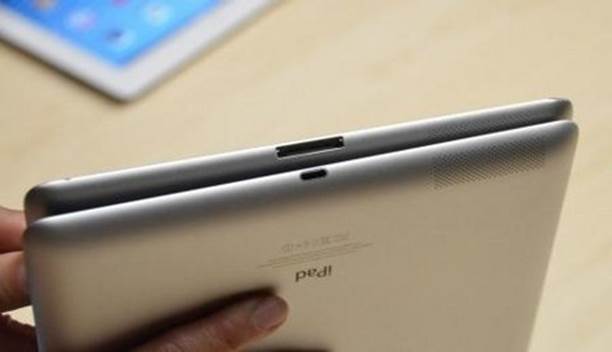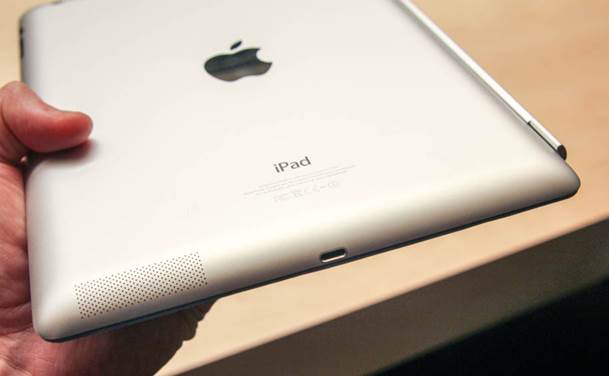EE is the only network that supports faster
4G connections (iPad 4 and mini), rolling out to a limited number of UK cities
by Christmas. Micro SIM currently available only from EE (other carriers can be
ordered when buying your iPad from the Apple Store). Wifi dongle plans also
available.

The
iPad 4
Officially termed the iPad with Retina
Display, the fourth-generation version of Apple’s original 9.7-inch tablet was
a surprise announcement alongside the iPad mini on 12 September. The wifi-only
model shipped soon afterwards, and has been relatively easy to buy, with the
online Apple Store listing stock for immediate delivery at the time of writing.
The Cellular option - renamed from ‘4G’ when it was pointed out to Apple that
there were no 4G networks to use it on outside the US, although the version
currently sold in the UK does work with EE’s new 4G service - is available to
order and due to ship ‘late November!
For the sake of simplicity, we’ll stick
with calling this device the iPad 4. Externally, it’s largely unchanged from
the ‘new iPad’, or iPad 3, that was released earlier this year and is now
superseded by it: slightly fatter than the iPad 2, but essentially the same
design, with its seamless glass front and tapered unibody aluminium back. As
before, there are 16, 32 and 64GB options for each of the Wi-Fi and Cellular
variants (no longer labelled on the device itself, so it takes a trip to
Settings to remind yourself of the capacity you bought), each in black or white
with a plain aluminium back. Only the new Lightning port, whose tiny dimensions
are all the more striking in this relatively broad case, distinguishes the
revised model, which carries the rest of its enhancements on the inside.
The Lightning connector is surely one of
the reasons this unexpected upgrade exists. Standardising the new interface
across the product line should help to make it feel less like an annoyingly
incompatible innovation and more like the norm - although Apple’s own
certification requirements are still delaying the arrival of third party accessories
for it. We still don’t know exactly how future iPad docks will get around the
lack of physical support provided by the tiny new plug, which is about the size
of a small zip pull. But the supplied charging cable demonstrates that the
connection itself works beautifully. You can slip in the plug either way round,
with no fiddling about; the solid end cap has none of the awkward sharp edges
of the old 30-pin Dock connector or the various USB formats, and once in place
it stays put with no wobbling.

The
Lightning connector is surely one of the reasons this unexpected upgrade
exists.
The iPad 4 is as heavy as the 3, which is
to say noticeably heavier than the iPad 2 but still quite manageable - at least
until you try a mini. This weight is almost all the result of the huge battery
that occupies most of the space inside and drives the increasingly
high-powered central and graphics processors and the multi-megapixel Retina
screen. Our Wi-Fi model took five hours to charge fully from zero using the
bundled 12 watt mains adaptor, which is rated higher than previous power
supplies. From there, Apple’s claim of 10 hours’ battery life seemed to hold up
just fine. The fact that you can use this device intensively for a full day
without worrying about finding power, and in practice often forget about charging
it over a week of occasional use, is one of the factors that makes the iPad so
much more useful than you might expect.
The camera on the back has the same basic 5
megapixel/l080p HD specification as the iPad 3’s (which matched the iPhone 4),
but has gained the feature amusingly referred to by Apple as ‘backside
illumination’, which helps maximise the amount of light reaching the sensor,
improving low-light shooting. As usual, it’s the superb auto-exposure and
colour balance as much as the sensor spec that makes the camera rewarding to
use. Shooting with a full-size iPad does still look ridiculous, but being able
to see what you’re shooting on a huge screen, then edit it immediately in
Photos, iPhoto, iMovie or your favourite third party app, gives you the last
laugh.

The
iPad 4 is as heavy as the 3, which is to say noticeably heavier than the iPad 2
but still quite manageable - at least until you try a mini.
Significantly, the front-facing FaceTime
camera has been upgraded to 1.2 megapixels and 720p, and now provides a much
higher-quality image for video calls. The only catch is that it still really
isn’t all that keen on low light, so if - like many creative types - you prefer
not to white out your office with the standard corporate billion-watt fluorescents,
you may find you still look a bit grainy. Again, though, the big screen - with
more than enough resolution to show every single pixel the camera is capturing
- makes FaceTime a gratifyingly futuristic experience.
The brain transplant is the biggest development in the iPad 4, yet the least visible.
Apple’s new A6X, one of the latest batch of systems-on-a-chip that incorporates
a CPU designed by Apple itself rather than semiconductor partners, is a32nm
custom dual core processor clocked at somewhere between 1.39 and 1.5GHz,
depending on who you believe. Geekbench initially reported a speed of 1.2GHz on
our unit, then later seemed to settle down and begin reliably reporting a speed
of 1.39GHz.
Compared to the iPad 3’s 1GHz, this seems
like a decent speed bump, but the CPU is essentially the same chip, so it’s
unlikely to show a big performance gain. Things have progressed more
dramatically in the graphics department. There are now four GPU cores instead
of three, as part of the new PowerVR SGX 554MP4 graphics processor (see p12).
Better still, these cores are each much more powerful, offering what amounts to
quite astonishing performance. The benchmarking tool SunSpider-which measures
the speed of processing JavaScript, a language very commonly used to add
interactivity to websites and HTML5apps - completed on our iPad 4 in about 830
milliseconds, compared to 1443ms for the iPad 3. More strikingly still, the
iPad 4’s Geekbench rating, an arbitrary score of processing power, was around
1770, versus the 3’s 754 - an incredible performance jump. For comparison,
this would beat a 2006 Mac mini. The full-size iPad is very clearly emerging as
more than just a glorified PDA.

The
iPad 4 has the same 1GB of RAM as the 3, so it’s the beefed-up processors alone
that are making the difference.
Much of the improvement comes from the
graphics processing, where statistics show the iPad 4 comfortably blows away
not only older iPads but also the impressively powerful iPhone 5- by a
considerable margin in some tests.
High numbers don’t always translate into
performance you can feel, but in practice everything about the iPad 4 is
snappier. Starting up from cold (not that you’ll ever need to do that unless
you’ve let the battery run out) is much faster; opening apps is even closer to
instantaneous; and code-heavy websites load quickly and scroll smoothly.
There’s just less lag, less waiting for things to happen. Although Apple
doesn’t talk about the amount of RAM it uses in iPads, since there’s nothing
the user can change and little to be gained by comparing it between devices,
the iPad 4 has the same 1GB of RAM as the 3, so it’s the beefed-up processors
alone that are making the difference.
It’s slightly surprising, therefore, to
find that raw processing tasks aren’t actually all that much faster than with
the iPad 3, or even the iPad 2, because the CPU isn’t where the money has gone.
Rendering out movies or GarageBand projects certainly isn’t twice as fast,
though it is a bit quicker. What’s more important, though, is that everyday
tasks feel really nice and fast. Most users will spend the vast majority of
their time browsing, emailing or gaming rather than rendering, and the speed
boost in these areas is well worth having. Loading web pages in Safari was
subjectively at least twice as fast as on an iPad 2 and noticeably faster than
on a 3.